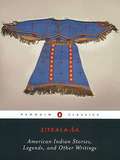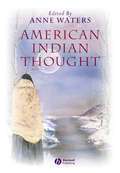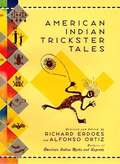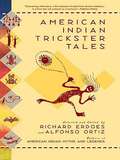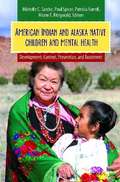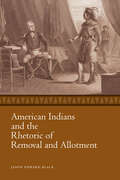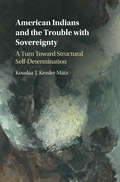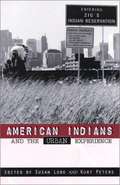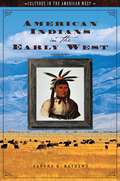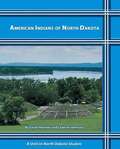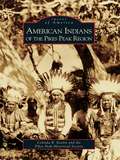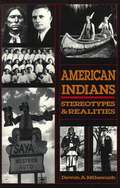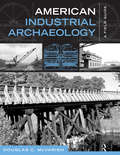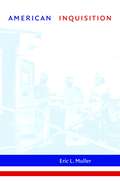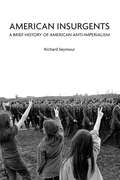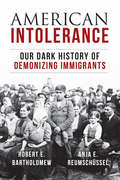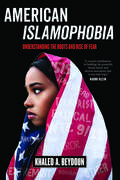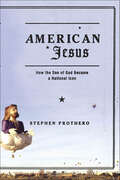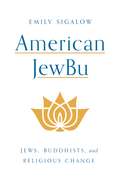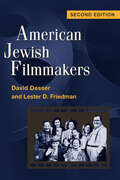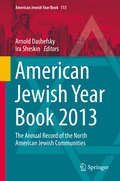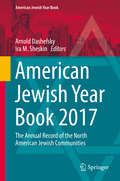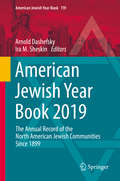- Table View
- List View
American Indian Stories, Legends, and Other Writings
by Zitkala-saZitkala-Sa wrestled with the conflicting influences of American Indian and white culture throughout her life. Raised on a Sioux reservation, she was educated at boarding schools that enforced assimilation and was witness to major events in white-Indian relations in the late 1800s and early 1900s. Tapping her troubled personal history, Zitkala-Sa created stories that illuminate the tragedy and complexity of the American Indian experience. In evocative prose laced with political savvy, she forces new thinking about the perceptions, assumptions, and customs of both Sioux and white cultures and raises issues of assimilation, identity, and race relations that remain compelling today. .
American Indian Thought: Philosophical Essays
by Anne WatersThis book brings together a diverse group of American Indian thinkers to discuss traditional and contemporary philosophies and philosophical issues.
American Indian Trickster Tales
by Richard Erdoes Alfonso Ortizit's the Trickster who provides the real spark in the action
American Indian Trickster Tales
by Richard ErdoesOf all the characters in myths and legends told around the world, it's the wily trickster who provides the real spark in the action, causing trouble wherever he goes. This figure shows up time and again in Native American folklore, where he takes many forms, from the irascible Coyote of the Southwest, to Iktomi, the amorphous spider man of the Lakota tribe. This dazzling collection of American Indian trickster tales, compiled by an eminent anthropologist and a master storyteller, serves as the perfect companion to their previous masterwork, American Indian Myths and Legends. American Indian Trickster Tales includes more than one hundred stories from sixty tribes? many recorded from living storytellers?which are illustrated with lively and evocative drawings. These entertaining tales can be read aloud and enjoyed by readers of any age, and will entrance folklorists, anthropologists, lovers of Native American literature, and fans of both Joseph Campbell and the Brothers Grimm. .
American Indian and Alaska Native Children and Mental Health: Development, Context, Prevention, and Treatment
by Paul Spicer Michelle C. Sarche Patricia Farrell Hiram E. FitzgeraldThis book examines the physical, psychological, social, and environmental factors that support or undermine healthy development in American Indian children, including economics, biology, and public policies.
American Indians and the American Dream: Policies, Place, and Property in Minnesota
by Kasey R. KeelerUnderstanding the processes and policies of urbanization and suburbanization in American Indian communities Nearly seven out of ten American Indians live in urban areas, yet studies of urban Indian experiences remain scant. Studies of suburban Natives are even more rare. Today&’s suburban Natives, the fastest-growing American Indian demographic, highlight the tensions within federal policies working in tandem to move and house differing groups of people in very different residential locations. In American Indians and the American Dream, Kasey R. Keeler examines the long history of urbanization and suburbanization of Indian communities in Minnesota.At the intersection of federal Indian policy and federal housing policy, American Indians and the American Dream analyzes the dispossession of Indian land, property rights, and patterns of home ownership through programs and policies that sought to move communities away from their traditional homelands to reservations and, later, to urban and suburban areas. Keeler begins this analysis with the Homestead Act of 1862, then shifts to the Indian Reorganization Act in the early twentieth century, the creation of Little Earth in Minneapolis, and Indian homeownership during the housing bubble of the early 2000s.American Indians and the American Dream investigates the ways American Indians accessed homeownership, working with and against federal policy, underscoring American Indian peoples&’ unequal and exclusionary access to the way of life known as the American dream. Cover alt text: Vintage photo of Native person bathing smiling child in the sink of a midcentury kitchen. Title in yellow.
American Indians and the Rhetoric of Removal and Allotment (Race, Rhetoric, and Media Series)
by Jason Edward BlackJason Edward Black examines the ways the US government’s rhetoric and American Indian responses contributed to the policies of Native–US relations throughout the nineteenth century’s removal and allotment eras. Black shows how these discourses together constructed the perception of the US government and of American Indian communities. Such interactions—though certainly not equal—illustrated the hybrid nature of Native–US rhetoric in the nineteenth century. Both governmental, colonizing discourse and indigenous, decolonizing discourse shaped arguments, constructions of identity, and rhetoric in the colonial relationship.American Indians and the Rhetoric of Removal and Allotment demonstrates how American Indians decolonized dominant rhetoric through impeding removal and allotment policies. By turning around the US government’s narrative and inventing their own tactics, American Indian communities helped restyle their own identities as well as the government’s. During the first third of the twentieth century, American Indians lobbied for the successful passage of the Indian Citizenship Act of 1924 and the Indian New Deal of 1934, changing the relationship once again.In the end, Native communities were granted increased rhetorical power through decolonization, though the US government retained an undeniable colonial influence through its territorial management of Natives. The Indian Citizenship Act and the Indian New Deal—as the conclusion of this book indicates—are emblematic of the prevalence of the duality of US citizenship that fused American Indians to the nation yet segregated them on reservations. This duality of inclusion and exclusion grew incrementally and persists now, as a lasting effect of nineteenth-century Native–US rhetorical relations.
American Indians and the Trouble with Sovereignty: A Turn Toward Structural Self-Determination
by Kessler-Mata Kouslaa T.With tribes and individual Indians increasingly participating in American electoral politics, this study examines the ways in which tribes work together with state and local governments to overcome significant governance challenges. Much scholarship on tribal governance continues to rely on a concept of tribal sovereignty that does not allow for or help structure this type of governance activity. The resulting tension which emerges in both theory and practice from American Indian intergovernmental affairs is illuminated here and the limits of existing theory are confronted. Kessler-Mata presents an argument for tribal sovereignty to be normatively understood and pragmatically pursued through efforts aimed at interdependence, not autonomy. By turning toward theories of federalism and freedom in the republican tradition, the author provides an alternative framework for thinking about the goals and aspirations of tribal self-determination.
American Indians and the Urban Experience
by Susan Lobo Kurt PetersThis is a collection of essays describing the Native Americans' experiences beyond the reservation.
American Indians in the Early West (Cultures in the American West)
by Sandra K. MathewsMathews (history, U. of New Mexico) offers an alternative view to histories that concentrate on the violent and often tragic confrontations between native Americans and Anglo-Americans in the 19th century. Instead, she concentrates on the clashes between the Indian nations and colonizers that began almost 300 years before the United States was born. Topics include the origins, migrations and geographical location of the earlier native Americans, the history of the Spanish in the southwest, the history of the French from the Saint Lawrence and Great Lakes to the Rocky Mountains and Russian involvement from the Aleutian Chain to Northern California. The book also addresses major issues in the study of American Indian history. Annotation ©2008 Book News, Inc., Portland, OR (booknews.com)
American Indians of North Dakota (North Dakota Studies)
by Gwyn S. Herman Laverne A. JohnsonThis book is filled with interesting history, impressive facts, and inspiring profiles. Through reading and engaging in the variety of activities that accompany this text, you will find yourself on a dynamic and educational journey of discovery.
American Indians of the Pikes Peak Region
by Pikes Peak Historical Society Celinda R. KaelinThousands of years before Zebulon Pike's name became attached to this famous mountain, Pikes Peak was home to indigenous people. These First Nations left no written record of their sojourn here, but what they did leave were stone circles, carefully crafted arrowheads and stone tools, enigmatic petroglyphs, and culturally scarred trees. In the 1500s, Spanish explorers documented their locations, language, and numbers. In the 1800s, mountain men and official explorers such as Pike, Fremont, and Long also wrote about these First Nations. Comanche, Apache, Arapaho, Cheyenne, Kiowa, and Lakota made incursions into the region. These nations contested Ute land possession, harvested the abundant wildlife, and paid homage to the powerful spirits at Garden of the Gods and Manitou Springs. Today Ute Indians return to Garden of the Gods and to Pikes Peak each year to perform their sacred Sundance Ceremony.
American Indians: Stereotypes and Realities
by Devon A. MihesuahAmerican Indians are portrayed in many ways, but often the portraits reflect more myth than reality. "This book is not intended to chronicle the history of any tribe or to analyze its culture, nor to detail intricacies of American Indian tribal politics, law, or economics. It is not intended to glorify Indians nor to criticize those people who believe the myths. Its purpose is to stimulate dialogue and to correct some of the most prevalent misconceptions about Indians. There are more, no doubt. But it is my hope that this bookwill spur teachers to fight for better textbooks-books that include a complete history of this country -and to push for multicultural curriculums. It is important for all of us to recognize and to combat stereotypes. All peoples deserve to have their histories and cultures properly placed in the scheme of things. Anything less does us all a disservice." Mihesuah includes a generous number of recommended readings.
American Industrial Archaeology: A Field Guide
by Douglas C McVarishThis comprehensive guide provides the reader with basic information of the most common types of structures, sites, and objects encountered in industrial archaeology. These include bridges, railroads, roads, waterways, several types of production and extraction factories, water and power generating facilities, and others. Each chapters contains a brief introduction to the technology or features of each class of installation, illustrations with characteristics that help identifying important elements of the type, and a glossary of common terms. Two chapters offer valuable guidance on researching industrial properties and landscapes. For students, avocational archaeologists, and cultural resource management surveys, this volume will be an essential reference.
American Infanticide: Sexism, Science, and the Politics of Sympathy (Critical Issues in Crime and Society)
by Clara S. LewisOn April 22, 2015, the sorority sisters at Ohio’s Muskingum University’s Delta house encountered a horrific scene: pools of blood and gore in the first-floor bathroom. No one knew exactly what had happened, but the sisters suspected it had something to do with Emile Weaver. Studious, athletic, and well-liked, Emile had recently started wearing bulky sweatsuits and hiding her midsection, as if she was covering up a sudden weight gain. Could Emile be pregnant? Emboldened by fear, the sorority sisters investigated. In the driveway next to the kitchen door, they found Emile’s newborn baby girl dead inside a garbage bag. Emile’s crime seemed senseless and left her family and friends with an aching question: what happened? American Infanticide situates Emile's tragic act in a long intellectual, social, and legal history, uncovering disturbing missing chapters in our national history that undercut myths that have shaped public reactions to so-called monster moms and dumpster babies since the colonial era. Ultimately, the book uncovers how bias and inconsistency dictate how women accused of infant homicide are perceived and punished and sheds new light on how and why our legal responses to infanticide are so deeply misguided.
American Inquisition
by Eric L. MullerWhen the U.S. government forced 70,000 American citizens of Japanese ancestry into internment camps in 1942, it created administrative tribunals to pass judgment on who was loyal and who was disloyal. In American Inquisition, Eric Muller relates the untold story of exactly how military and civilian bureaucrats judged these tens of thousands of American citizens during wartime. Some citizens were deemed loyal and were freed, but one in four was declared disloyal to America and condemned to repressive segregation in the camps or barred from war-related jobs. Using cultural and religious affiliations as indicators of Americans' loyalties, the far-reaching bureaucratic decisions often reflected the agendas of the agencies that performed them rather than the actual allegiances or threats posed by the citizens being judged, Muller explains.American Inquisition is the only study of the Japanese American internment to examine the complex inner workings of the most draconian system of loyalty screening that the American government has ever deployed against its own citizens. At a time when our nation again finds itself beset by worries about an "enemy within" considered identifiable by race or religion, this volume offers crucial lessons from a recent and disastrous history.
American Insurgents
by Richard Seymour"Seymour's obsessively researched, impressive first book holds its place as the most authoritative historical analysis of its kind."--Resurgence All empires spin self-serving myths, and in the United States the most potent of these is that America is a force for democracy around the world. Yet there is a tradition of American anti-imperialism which gives the lie to this mythology. Richard Seymour examines this complex relationship from the Revolution to the present-day. Richard Seymour is a socialist writer and runs the blog Lenin's Tomb. He is the author of The Liberal Defense of Murder. His articles have appeared in the Guardian and New Statesman.
American Intolerance: Our Dark History of Demonizing Immigrants
by Robert E. Bartholomew Anja ReumschuesselThis historical review of the US treatment of immigrants and minority groups documents the suspicion and persecution that often met newcomers and those perceived to be different.Contrary to popular belief, the poor and huddled masses were never welcome in America. Though the engraving on the base of the Statue of Liberty makes that claim, history reveals a far less-welcoming message. This comprehensive survey of cultural and racial exclusion in the United States examines the legacy of hostility toward immigrants over two centuries. The authors document abuses against Catholics in the early 19th century in response to the influx of German and Irish immigrants; hostility against Mexicans throughout the Southwest, where signs in bars and restaurants read, "No Dogs, No Negros, No Mexicans"; "yellow peril" fears leading to a ban on Chinese immigration for ten years; punitive measures against Native Americans traditions, which became punishable by fines and hard labor; the persecution of German Americans during World War I and Japanese Americans during World War II; the refusal to admit Jewish refugees of the Holocaust; and the ongoing legacy of mistreating African Americans from slavery to the injustices of the present day.Though the authors note that the United States has accepted tens of millions of immigrants during its relatively short existence, its troubling history of persecution is often overlooked. President Donald Trump's targeting of Muslim and Mexican immigrants is just the most recent chapter in a long, sad history of social panics about "evil" foreigners who are made scapegoats due to their ethnicity or religious beliefs.
American Islamophobia: Understanding The Roots And Rise Of Fear
by Khaled A. Beydoun“I remember the four words that repeatedly scrolled across my mind after the first plane crashed into the World Trade Center in New York City. ‘Please don’t be Muslims, please don’t be Muslims.’ The four words I whispered to myself on 9/11 reverberated through the mind of every Muslim American that day and every day after.… Our fear, and the collective breath or brace for the hateful backlash that ensued, symbolize the existential tightrope that defines Muslim American identity today.” The term “Islamophobia” may be fairly new, but irrational fear and hatred of Islam and Muslims is anything but. Though many speak of Islamophobia’s roots in racism, have we considered how anti-Muslim rhetoric is rooted in our legal system? Using his unique lens as a critical race theorist and law professor, Khaled A. Beydoun captures the many ways in which law, policy, and official state rhetoric have fueled the frightening resurgence of Islamophobia in the United States. Beydoun charts its long and terrible history, from the plight of enslaved African Muslims in the antebellum South and the laws prohibiting Muslim immigrants from becoming citizens to the ways the war on terror assigns blame for any terrorist act to Islam and the myriad trials Muslim Americans face in the Trump era. He passionately argues that by failing to frame Islamophobia as a system of bigotry endorsed and emboldened by law and carried out by government actors, U.S. society ignores the injury it inflicts on both Muslims and non-Muslims. Through the stories of Muslim Americans who have experienced Islamophobia across various racial, ethnic, and socioeconomic lines, Beydoun shares how U.S. laws shatter lives, whether directly or inadvertently. And with an eye toward benefiting society as a whole, he recommends ways for Muslim Americans and their allies to build coalitions with other groups. Like no book before it, American Islamophobia offers a robust and genuine portrait of Muslim America then and now.
American Jesus: How the Son of God Became a National Icon
by Stephen ProtheroA Deep Dive into America's Complex Relationship with JesusThere's no denying America's rich religious background–belief is woven into daily life. But as Stephen Prothero argues in American Jesus, many of the most interesting appraisals of Jesus have emerged outside the churches: in music, film, and popular culture; and among Jews, Muslims, Buddhists, and people of no religion at all.Delve into this compelling chronicle as it explores how Jesus, the carpenter from Nazareth, has been refashioned into distinctly American identities over the centuries. From his enlistment as a beacon of hope for abolitionists to his appropriation as a figurehead for Klansmen, the image of Jesus has been as mercurial as it is influential. In this diverse and conflicted scene, American Jesus stands as a testament to the peculiar fusion of the temporal and divine in contemporary America.Equal parts enlightening and entertaining, American Jesus goes beyond being simply a work of history. It’s an intricate mirror, reflecting the American spirit while questioning the nation's socio-cultural fabric.
American JewBu: Jews, Buddhists, and Religious Change
by Emily SigalowA revealing look at the Jewish American encounter with BuddhismToday, many Jewish Americans are embracing a dual religious identity, practicing Buddhism while also staying connected to their Jewish roots. This book tells the story of Judaism's encounter with Buddhism in the United States, showing how it has given rise to new contemplative forms within American Judaism—and shaped the way Americans understand and practice Buddhism.Taking readers from the nineteenth century to today, Emily Sigalow traces the history of these two traditions in America and explains how they came together. She argues that the distinctive social position of American Jews led them to their unique engagement with Buddhism, and describes how people incorporate aspects of both into their everyday lives. Drawing on a wealth of original in-depth interviews conducted across the nation, Sigalow explores how Jewish American Buddhists experience their dual religious identities. She reveals how Jewish Buddhists confound prevailing expectations of minority religions in America. Rather than simply adapting to the majority religion, Jews and Buddhists have borrowed and integrated elements from each other, and in doing so they have left an enduring mark on the American consciousness.American JewBu highlights the leading role that American Jews have played in the popularization of meditation and mindfulness in the United States, and the profound impact that these two venerable traditions have had on one another.
American Jewish Filmmakers
by Lester D. Friedman David DesserWoody Allen, Mel Brooks, Sidney Lumet, and Paul Mazursky, all sons of East European Jews, remain among the most prominent contemporary American film directors. In this revised, updated second edition of American Jewish Filmmakers, David Desser and Lester D. Friedman demonstrate how the Jewish experience gives rise to an intimately linked series of issues in the films of these and other significant Jewish directors. The effects of the Holocaust linger, both in gripping dramatic form (Mazursky's Enemies, a Love Story) and in black comedy (Brooks's The Producers). In his trilogy consisting of Serpico, Prince of the City, and Q&A, Lumet focuses on the failure of society's institutions to deliver social justice. Woody Allen portrays urban life and family relationships (Manhattan and Hannah and Her Sisters), sometimes with a nostalgic twist (Radio Days). This edition concludes with a newly written discussion of the careers of other prominent Jewish filmmakers such as Steven Spielberg, Barry Levinson, Brian Singer, and Darren Aronofsky.
American Jewish Year Book 2012: The Annual Record of the North American Jewish Communities (American Jewish Year Book #113)
by Ira Sheskin Arnold DashefskyThe 2012 American Jewish Year Book, "The Annual Record of American Jewish Civilization," contains major chapters on Jewish secularism (Barry Kosmin and Ariela Keysar), Canadian Jewry (Morton Weinfeld, David Koffman, and Randal Schnoor), national affairs (Ethan Felson), Jewish communal affairs (Lawrence Grossman), Jewish population in the United States (Ira Sheskin and Arnold Dashefsky), and World Jewish population (Sergio DellaPergola). These chapters provide insight into major trends in the North American and world Jewish community. The volume also acts as a resource for the American Jewish community and for academics studying that community by supplying obituaries and lists of Jewish Federations, Jewish Community Centers, national Jewish organizations, Jewish overnight camps, Jewish museums, Holocaust museums, local and national Jewish periodicals, Jewish honorees, major recent events in the American Jewish community, and academic journals, articles, websites, and books. The volume should prove useful to social scientists and historians of the American Jewish community, Jewish communal workers, the press, and others interested in American and Canadian Jews.
American Jewish Year Book 2017: The Annual Record of the North American Jewish Communities (American Jewish Year Book #117)
by Arnold Dashefsky Ira M. SheskinThe American Jewish Year Book, now in its 117th year, is the annual record of the North American Jewish communities and provides insight into their major trends. The first chapter of Part I is an examination of how American Jews fit into the US religious landscape, based on Pew Research Center studies. The second chapter examines intermarriage. Chapters on "The Domestic Arena" and "The International Arena" analyze the year's events as they affect American Jewish communal and political affairs. Three chapters analyze the demography and geography of the US, Canada, and world Jewish populations. Part II provides lists of Jewish institutions, including federations, community centers, social service agencies, national organizations, synagogues, Hillels, day schools, camps, museums, and Israeli consulates. The final chapters present national and local Jewish periodicals and broadcast media; academic resources, including Jewish Studies programs, books, journals, articles, websites, and research libraries; and lists of major events in the past year, Jewish honorees, and obituaries.
American Jewish Year Book 2019: The Annual Record of the North American Jewish Communities Since 1899 (American Jewish Year Book #119)
by Arnold Dashefsky Ira M. SheskinPart I of each volume will feature 5-7 major review chapters, including 2-3 long chapters reviewing topics of major concern to the American Jewish community written by top experts on each topic, review chapters on "National Affairs" and "Jewish Communal Affairs" and articles on the Jewish population of the United States and the World Jewish Population. Future major review chapters will include such topics as Jewish Education in America, American Jewish Philanthropy, Israel/Diaspora Relations, American Jewish Demography, American Jewish History, LGBT Issues in American Jewry, American Jews and National Elections, Orthodox Judaism in the US, Conservative Judaism in the US, Reform Judaism in the US, Jewish Involvement in the Labor Movement, Perspectives in American Jewish Sociology, Recent Trends in American Judaism, Impact of Feminism on American Jewish Life, American Jewish Museums, Anti-Semitism in America, and Inter-Religious Dialogue in America. Part II-V of each volume will continue the tradition of listing Jewish Federations, national Jewish organizations, Jewish periodicals, and obituaries. But to this list are added lists of Jewish Community Centers, Jewish Camps, Jewish Museums, Holocaust Museums, and Jewish honorees (both those honored through awards by Jewish organizations and by receiving honors, such as Presidential Medals of Freedom and Academy Awards, from the secular world). We expand the Year Book tradition of bringing academic research to the Jewish communal world by adding lists of academic journals, articles in academic journals on Jewish topics, Jewish websites, and books on American and Canadian Jews. Finally, we add a list of major events in the North American Jewish Community.
